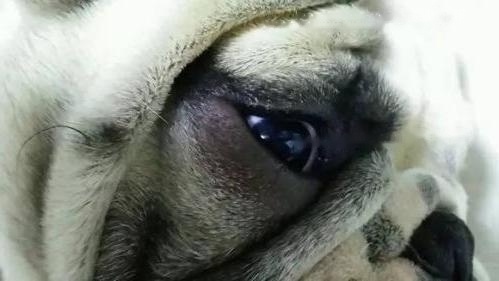The 3-year-old Pitbull ugly child, who had undergone surgery to remove the third eyelid hyperplasia two years ago. Recently, the owner found that the secretions in both eyes increased, and he came to the doctor for examination and found severe dry eye. Ugly children will rely on artificial tears to accompany them for the rest of their years - Dr. Jiang Tao from Qujing, Yunnan

dogs the surface of the eyeball is continuously protected by a film of tears In addition, it has a moisturizing effect, aids in the healing of eye trauma and prevents eye infections. Like a hydrating mask on the skin, it locks in moisture, keeps it hydrated, and blocks invasion. The tears that nourish the ocular surface are secreted by the lacrimal glands, while the outer layer of the water-locking tear film is mainly composed of lipids secreted by the meibomian glands. Without this layer of lipids, tears evaporate quickly and the eyes dry out. When the quality and quantity of this layer of tears are abnormal, the tear film will be damaged, causing eye discomfort or visual dysfunction, such as: dry eyes, photophobia, wind and redness, redness and itching, heavy eyelids, excessive secretions, blurred vision , foreign body sensation, unidentified tears...
Dog dry eye syndrome has been proven to be the basis of stubborn lacrimal gland degeneration and inflammation, and cannot be completely cured. What are the reasons for dog dry eye syndrome? ? Xiaobian to tell you, only to find the root cause can be effective prevention.
1. Drugs: Sulfonium ammonium drugs (some eye drops commonly used by people) can cause dry eyes in dogs.
2. Caused by surgery: Dry eye caused by surgical removal of the prolapsed third eyelid gland (cherry eye).
3. Spontaneous and senile: The cause of dry eye in dogs is related to the aging of the animal and the gradual shrinking of the lacrimal gland.
4. Caused by autoimmunity: up to 30% of dry eye caused by spontaneous autoimmunity is related to the destruction of the lacrimal gland and the third eyelid gland by autoimmunity. Among the dry eye cases in the ophthalmology clinic of National Taiwan University Animal Hospital, there is a significantly higher proportion of abnormal immune conditions, including allergies or hair follicle infection.
5. Trauma caused by or under the eye socket: The lacrimal gland and the third eyelid gland are damaged due to trauma, or the nerves in charge of the lacrimal gland and the third eyelid gland are damaged, and the secretion of tears becomes unusual.
6. Caused by canine distemper: Canine distemper virus can affect the lacrimal gland and the third eyelid gland, resulting in temporary or permanent loss of tear secretion.
7. Congenital or genetic: Congenital acinar hypoplasia often occurs in young or young adult dogs of miniature breeds, such as Chihuahua and YorkshireDogs, etc. In addition, dog breeds with hereditary predisposition to dry eye syndrome (but not necessarily the age of onset) are often associated with autoimmune attacks on the lacrimal gland. Dog breeds include Maltese, Yorkshire terriers, Shishi Tzu (details), Pug, Peking, Boston Terrierdog, West Highland Terrier, King Charles Spaniel, Lhasa Apso, Englishcocker, American Cocker Spaniel and English Bulldog, etc.
8. Lack of sensory nerve distribution on the surface of the eyeball (craninal nerve V).
9. The lacrimal gland lacks the distribution of parasympathetic sensory nerves (craninal nerve VII).
10. Other causes: Many unproven or unknown factors have been proposed.
![[Dog Training 5] The training method of pet dog dining etiquette](/static/img/12192/12192_1.jpg)




